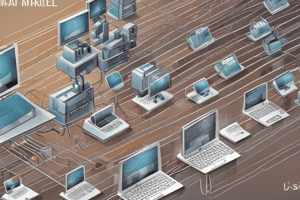Podcast
Questions and Answers
What is the Internet?
What is the Internet?
A computer network that interconnects billions of computing devices throughout the world.
Which of the following devices are considered end systems in the context of the Internet?
Which of the following devices are considered end systems in the context of the Internet?
- Laptops (correct)
- Gaming consoles (correct)
- Servers (correct)
- Desktop PCs (correct)
The basic hardware and software components of the Internet provide a _______ description.
The basic hardware and software components of the Internet provide a _______ description.
nuts and bolts
Traditional devices connecting to the Internet only include desktop PCs and servers.
Traditional devices connecting to the Internet only include desktop PCs and servers.
What types of communication links are mentioned as connecting devices in the Internet?
What types of communication links are mentioned as connecting devices in the Internet?
What do packet switches do in a network?
What do packet switches do in a network?
Which statement best describes the Internet?
Which statement best describes the Internet?
Lower-tier ISPs are interconnected through national and international _______.
Lower-tier ISPs are interconnected through national and international _______.
Flashcards are hidden until you start studying
Study Notes
Overview of Telecommunications and Computer Networks
- The course explores foundational concepts of telecommunications and computer networks through a top-down approach using the Internet as a central example.
- Key topics include understanding network terminology, protocols, and the structure of the Internet.
What is the Internet?
- Defined as both a collection of hardware and software components forming a global network of interconnected devices.
- Functions as a networking infrastructure that supports distributed applications.
Network Edge
- Consists of end systems (hosts) and access networks linking devices to the Internet.
- End systems include traditional (PCs, servers) and non-traditional devices (phones, gaming consoles, sensors).
Network Core
- Comprises infrastructure including packet switching and circuit switching systems responsible for data transmission.
- Packet switches forward chunks of data (packets) via routers and link-layer switches.
Network Performance
- Key performance metrics include packet loss, delay, and throughput (measured in bits per second, bps).
- Understanding these metrics is crucial for assessing network efficiency and effectiveness.
Protocol Layers and Service Models
- Layers of protocols govern communication processes, supporting various service models that facilitate data exchange across networks.
Security in Networks
- Networks face threats including denial-of-service (DDoS) attacks and other vulnerabilities that can compromise data integrity and availability.
Internet Growth and Statistics
- Significant increase in Internet users across global regions highlighted in recent reports.
- Understanding the explosive growth and trends in Internet usage assists in contextualizing current network demands.
History of the Internet
- Historical perspective on the development of the Internet, including advances in technology and changes in service models over time.
Fun and Innovative Internet-Connected Devices
- Examples include web-enabled toasters, sensorized mattresses, and smart appliances, showcasing the diverse applications of Internet connectivity beyond traditional computing devices.
The Structure of Internet Providers
- The Internet operates as a "network of networks," where interconnected Internet Service Providers (ISPs) allow end systems to access the network.
- Connections among ISPs occur at various tiers, from lower-tier regional ISPs to upper-tier national and international ISPs, with high-speed routers facilitating data traffic.
Studying That Suits You
Use AI to generate personalized quizzes and flashcards to suit your learning preferences.




